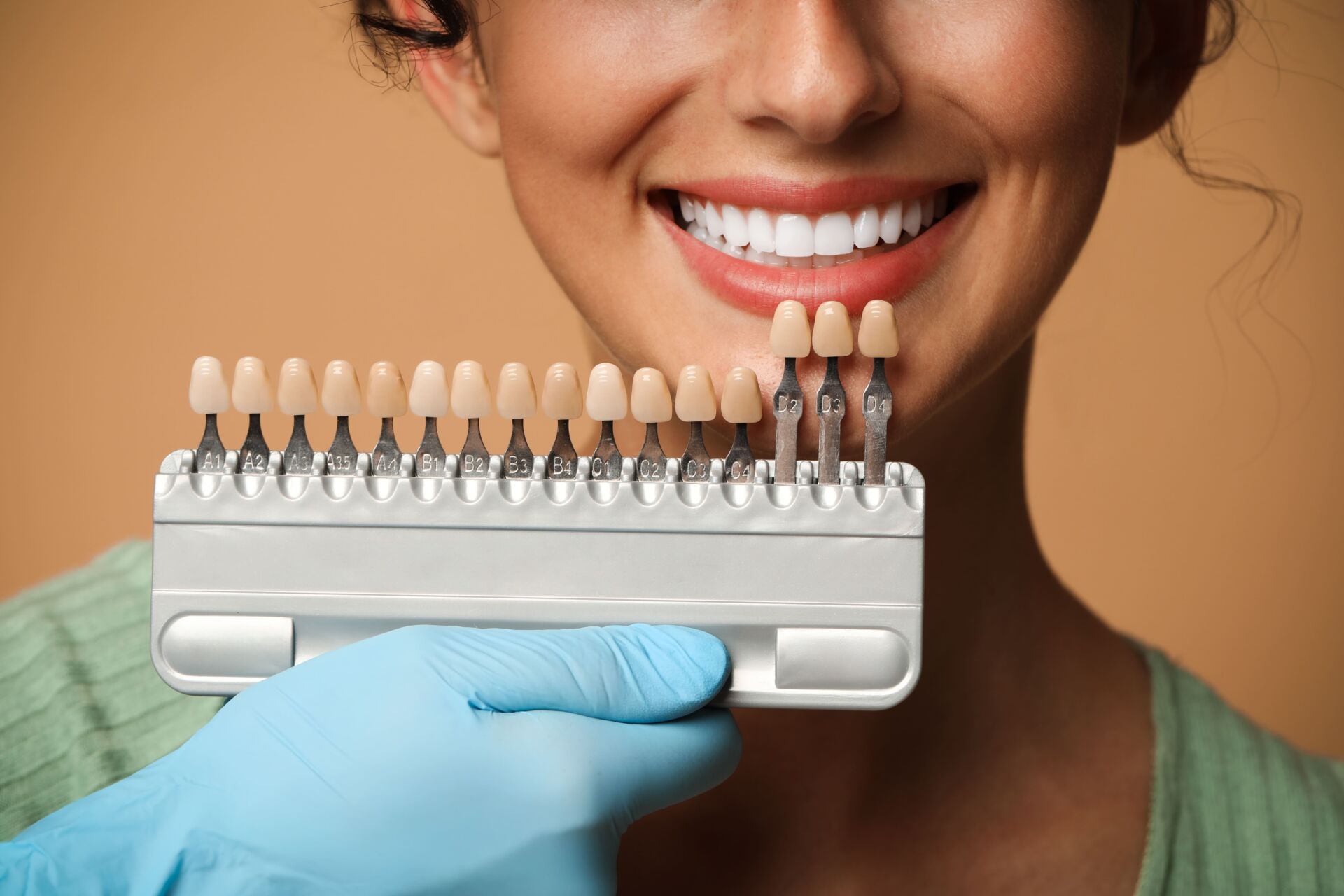Your smile is your signature, a window to your personality, and a powerful tool for making lasting impressions. But what if your smile has seen better days? Stains, chips, gaps, or misalignments can dampen your self-confidence and leave you hiding your grin. Fortunately, there’s a transformative solution that’s been changing the lives of our patients on smile at a time: porcelain veneers.
This cosmetic dentistry treatment is more than just thin shells of porcelain; they are a gateway to renewed confidence and a radiant smile that can leave a lasting impact.
What Are Porcelain Veneers?
Porcelain veneers are thin, custom-made shells of dental porcelain that are designed to cover the front surface of a tooth, known for their ability to mimic the appearance of natural teeth. These veneers are used to improve the appearance of teeth that have cosmetic imperfections. Widely known as the secret to a “Hollywood Smile”, porcelain veneers are a popular choice for individuals seeking to enhance their smiles and achieve a more aesthetically pleasing and uniform look for their teeth.
The process of getting porcelain veneers typically involves several steps:
- Consultation – The first step is to consult with a dentist or cosmetic dentist to determine if porcelain veneers are a suitable option for your specific needs and goals. They will evaluate your oral health, discuss your expectations, and explain the procedure in detail.
- Preparation – To make room for the veneers and ensure a proper fit, a small amount of enamel is usually removed from the front surface of the teeth receiving the veneers. This step is irreversible, as it involves removing a portion of the tooth’s natural structure.
- Impression – After the teeth are prepared, an impression or mold is taken of the teeth. This mold is used to create custom veneers that match the shape, size, and color of your natural teeth.
- Fabrication – Skilled dental technicians in a laboratory use the impression to fabricate the porcelain veneers. The porcelain used is chosen for its natural appearance and ability to reflect light similar to natural tooth enamel.
- Bonding – Once the veneers are ready, they are carefully bonded to the front surfaces of the teeth using a dental adhesive. The dentist ensures that they are positioned correctly and that the fit is precise.
- Final adjustments – After the veneers are bonded in place, any necessary adjustments are made to ensure that they feel comfortable and look natural. This may include trimming or polishing the veneers.
How Porcelain Veneers Can Transform Your Smile (And Change Your Life)
The results of porcelain veneers are not merely aesthetic; they can dramatically impact a person’s overall quality of life.
A Radiant Smile And Boosted Self-Confidence
One of the most immediate and profound effects of porcelain veneers is the transformation of a person’s smile. Whether you have stained teeth, gaps, misaligned teeth, or chips and cracks, veneers can create a flawless and radiant smile. The veneers are custom-made to match the shape, size, and color your natural teeth, making them virtually indistinguishable from the real thing.
This enhancement in smile aesthetics can result in a significant boost in self-confidence. Many individuals who have felt self-conscious about their teeth find a newfound sense of pride and self-assurance after getting porcelain veneers. This newfound confidence often extends beyond their smiles, positively affecting their personal and professional lives.
Improved Oral Health
Porcelain veneers don’t just provide cosmetic benefits; they can also lead to improved oral health. When teeth are discolored or damaged, they are often more susceptible to decay and further damage. Veneers act as a protective barrier, preventing further deterioration and preserving the structural integrity of the teeth they cover.
Veneers are also resistant to staining from food and drinks, unlike natural teeth. This means that individuals with veneers can enjoy their favorite beverages without worrying about the usual tooth discoloration. However, it’s important to maintain proper dental hygiene, such as regular brushing, flossing, and dental check-ups, to ensure the longevity of your veneers and overall oral health.
Long-Lasting Results
One of the remarkable aspects of porcelain veneers is their durability. When properly cared for, veneers can last for a decade or more because of the high-quality materials used in their construction and the meticulous craftsmanship involved in their placement.
Compared to alternative cosmetic dental procedures like teeth whitening, which may need frequent touch-ups, veneers offer a more enduring solution. This means that the initial investment in veneers pays off in terms of both long-term cost-effectiveness and lasting benefits.
Minimally Invasive Procedure
Unlike other dental treatments that may require extensive tooth reduction or surgery, the placement of porcelain veneers is a minimally invasive procedure. Dentists only need to remove a small amount of enamel from the front surface of the teeth to make room for the veneers. This means less discomfort, a shorter recovery time, and minimal disruption to daily life.
Making Porcelain Veneers and Good Oral Health Last
At Pittsburgh Dentist, our cosmetic dentistry practice stands out by embracing a holistic approach, recognizing that true oral health encompasses more than just surface aesthetics. Rather than rushing into porcelain veneer placement, we take the time to assess and address any underlying bite issues or misalignments.
By correcting these fundamental problems first, we ensure that the investment in porcelain veneers not only results in a stunning smile but also contributes to better oral health and longevity. This approach not only enhances the durability of the veneers but also enhances our patient’s overall oral health, providing a holistic and lasting transformation!




